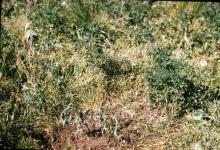Cause Several genera of fungi: Fusarium spp., Phoma, Pythium, Rhizoctonia as well as bacteria (Pseudomonas, Serratia) are associated with crown rot of alfalfa. These pathogens are common in most fields and may invade plants weakened by foliar diseases, insects, frost damage, low soil fertility, poor drainage, or summer drought-factors that may predispose plants to crown rot. Physical injury from soil heaving, tractors, or grazing animals can also promote crown rot.
Symptoms Rot develops in the tap root and crown area and over several years, plant vigor declines and finally the whole crown will die.
Cultural control
- Promote vigorous growth with proper fertility and irrigation practices.
- Control foliar diseases and insect problems.
- Avoid cutting hay when soils are wet.
- Avoid heavy grazing.
- Control weeds with herbicides and avoid cultivation practices, which damage crowns.
- Avoid field sites with heavy or poorly-drained soils.
- Rotate out of alfalfa for 2 to 3 years.
Biological control
- Bexfond at 7 to 14 fl oz/A. 4-hr reentry. O


